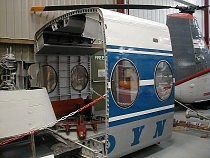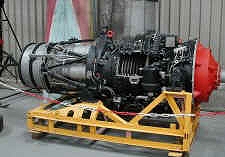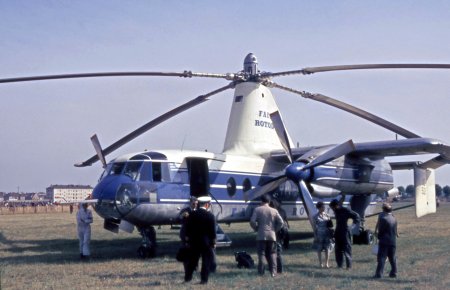Fairey Rotodyne
| On 6th December 2012 The Helicopter Museum put three models of the unique Fairey Rotodyne compound helicopter on display, complementing the only surviving sections of the actual aircraft that are also part of the collection. | ||
The models, originally commissioned by the Fairey company in the 1950s, have been transferred from the Imperial War Museum store at Duxford, Cambridge and are on display for the first time in 50 years. One represents an early 1952 proposal for the vertical takeoff airliner and a second represents the final proposed Rotodyne Z of 1960, just before the project was cancelled. The third model represents the prototype Rotodyne Y, as built and flown between 1957 and 1961. In 1981 The Helicopter Museum was able to acquire a few remaining major Rotodyne components including a 2m section of the fuselage, one Napier Eland 504 turboprop engine, the rotor head with pylon internal structure, a complete test rotor blade and several tip jets. Most of the items were refurbished, by the Museum, in 1995/96, and are now on public display. 2022 marks the 60th anniversary of the project's cancellation. Rotodyne is often described as an "idea before its time" and remains the subject of much interest by a worldwide aerospace industry which continues to seek a means of inter-city travel that doesn't require airport runways. |
 |
|
| The Rotodyne was a large compound helicopter,
designed and built by the Fairey Aviation Company in the late 1950s. It was a bold concept, taking the form of a 53,000lb, 65 seat, VTOL airliner, capable of operating from city centre heliports, which could also be constructed as an even heavier military transport. Both would combine helicopter and gyroplane technology to achieve forward speeds in excess of 200 mph. |
|||
|
|
One very successful 33,000lb,
40 seat demonstrator prototype was produced, which first flew in
1957. In the course of a four year concept proving programme it
claimed a world record speed of 190.9 mph over a 100 km closed circuit.
In June 1959 it flew from London to Paris, via Brussels, halving the time taken by any other rotary wing aircraft of the day. The Rotodyne was never allowed to fulfil its promise and the sole prototype was destroyed in 1962, before any steps could be taken to preserve what had been so painstakingly gained. |
||
In
1981 The Helicopter Museum was able to acquire a few remaining
major Rotodyne components including a 2m section of the fuselage, one Napier Eland 504 turboprop engine, the rotor head with pylon internal structure, a complete test rotor blade and several tip jets. Most of the items were refurbished, by the Museum, in 1995/96, and are now on public display. Pictures below. |
|||
 |
 |
 |
||||
